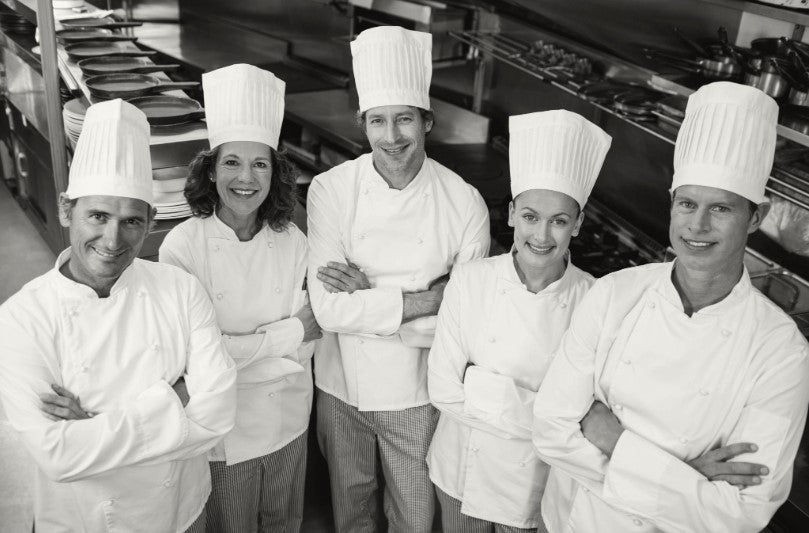TL:DR:
- Chef uniforms have historical significance, promote hygiene, and offer protection.
- The classic chef attire includes a toque (hat), double-breasted jacket, apron, pants, and non-slip, close-toed shoes.
- Dress codes can vary depending on the restaurant type and the chef's role.
- Modern variations include different colors and personal branding.
- The chef's uniform is a symbol of pride and professionalism.
Have you ever wondered why chefs look so sharp in their uniforms? It's not just about aesthetics. The chef's dress code combines tradition, practicality, and safety.
Each element of the uniform, from the iconic toque to the double-breasted jacket, serves a purpose.
Whether you're an aspiring culinary student, a seasoned chef, or a curious foodie, understanding the chef's dress code is insightful. It reveals important aspects of the culinary profession.
The Purpose of the Chef Dress Code
Chefs usually stick to a specific dress code for a few key reasons:
- Tradition: The chef's uniform has been around since the 19th century, thanks to famous French chef Marie-Antoine Carême. Wearing it honors this history and the culinary profession.
- Hygiene: Kitchens are busy places where food safety is crucial. The white uniform helps keep things clean by making stains obvious, so spills get cleaned up right away.
- Protection: The thick fabric and layers of the uniform can protect chefs from burns and spills.
- Professionalism: The uniform shows that the wearer is a chef, giving them a sense of authority and expertise.
- Identification: In a hectic kitchen, it's important to know who's who. The uniform makes it easy to spot chefs and helps keep everything running smoothly.
White is the traditional and most common color for chef uniforms because it reflects heat and shows cleanliness. However, modern kitchens are starting to use other colors, like black, and even adding personal branding. Despite these changes, the main ideas of practicality, hygiene, and professionalism are still central to the chef's dress code, no matter the color.
A Breakdown of The Classic Chef Attire
So, what do chefs wear? The classic chef outfit usually includes several key pieces, with some variations depending on the place.
- Toque (Chef's Hat): This tall, white hat is a recognizable symbol of the chef, with its height historically indicating rank. While still worn by some, many modern chefs opt for more practical headwear to maintain hygiene and comfort in the kitchen.
- Double-Breasted Jacket: This thick, white chef coat protects the chef from burns and spills. Its double-breasted design can be reversed if it gets stained, keeping the chef looking clean.
- Apron: The apron keeps the chef's clothes safe from splatters and stains. It’s also handy for wiping hands and holding tools.
- Pants: Chef pants are usually made of durable fabric like cotton or a cotton blend. Checkered pants are a classic, but plain black or white pants work too.
- Non-slip Shoes: Safety is key in the kitchen, so chefs wear non-slip, closed-toe shoes to prevent falls and protect their feet from spills and hot objects.
Variations in Chef Attire by Establishment
While the basics of a chef's outfit stay the same, there can be some differences depending on the type of place.
Fine Dining
In upscale restaurants, the dress code tends to be more formal. Chefs might wear elaborate coats with the restaurant's logo and stylish aprons.
Casual Dining
In more relaxed settings, the dress code is slightly more casual. Chefs might wear short-sleeved jackets or baseball caps. Cleanliness and professionalism are still important, but there's more room for personal style.
No matter the establishment, the chef's uniform symbolizes pride and dedication to the culinary craft.
Dress Codes for Different Chef Roles
While the classic chef attire is the foundation, the dress code can vary depending on a chef's specific role and responsibilities.
Here's how the dress code differs for different chef positions:
Executive Chef Dress Code
As the head of the kitchen, the executive chef's attire is often more formal and authoritative. They might still wear the traditional white jacket and toque but often go for a longer, tailored coat or even a suit in some upscale establishments. Their apron might be embroidered with their name or the restaurant's logo, showing their leadership role.
Sous Chef Dress Code
The sous chef, second in command to the executive chef, usually dresses like the line cooks. However, they might wear something like a different-colored apron to stand out. This makes them easy to spot in a busy kitchen and reinforces their role as a leader and mentor to the other cooks.
Pastry Chef Dress Code
Pastry chefs, who specialize in desserts and baked goods, usually follow the same dress code as other chefs. They maintain cleanliness and professionalism, but their white coats and aprons may feature unique designs or patterns related to pastries.
So, next time you see a chef in their uniform, take a moment to appreciate the history and high standards behind their attire.
Want to bring that same professionalism to your kitchen? Check out our collection of chef essentials at BlueCut. We offer high-quality, professional-grade gear to help you look and feel your best while you cook.


